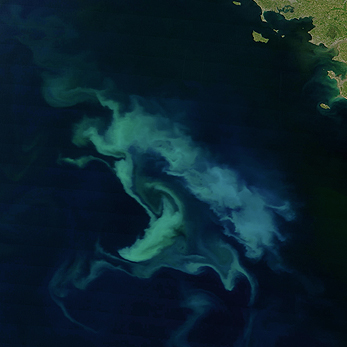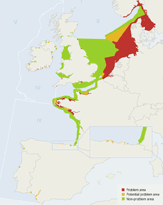How does this affect the quality status?
Eutrophication is still a problem in Regions II, III and IV
A healthy marine environment where no eutrophication occurs was not achieved over the assessment period (2001–2005) and will only be partially achieved by 2010. Anthropogenic nutrient enrichment of marine waters is still causing eutrophication in areas of Region II, and in some coastal embayments and estuaries within Regions III and IV. Regions I and V are not affected by eutrophication Figure 4.7.
Many of the indicators taken into account when assessing eutrophication are above the acceptable deviation from background conditions. Nutrient, chlorophyll and oxygen concentrations are the most widely used indicators across the OSPAR area. Eutrophication problems are more apparent in coastal areas, that is, closer to the main nutrient sources and where environmental conditions (e.g. restricted circulation, resuspension of nutrients in shallow waters) make them susceptible to eutrophication. In offshore areas, dilution generally ensures lower nutrient concentrations, but the origin of the nutrients is less clear owing to transport by ocean currents.
Region II is most widely affected
The eutrophication status of Region II over the assessment period (2001–2005) was not significantly different to that during the first assessment period (1990–2000) under the Common Procedure. Region II is the most widely affected Region with large areas along the continental coast from France to Norway and Sweden and a number of estuarine areas on the UK North Sea coast still adversely affected by eutrophication Figure 4.7.
In the period 2001–2005 severe eutrophication effects have occurred in various coastal areas with adverse impacts on ecosystems and society:
- In some estuaries in the Netherlands a die-off of cultured mussels and benthic animals has been linked to the decay of massive algal blooms.
- Kills of fish and invertebrates due to extreme oxygen deficiency occurred in fjords and estuaries of Sweden and Denmark. Kills of benthic invertebrates also occurred in Norwegian fjords.
- Toxic hydrogen sulphide released from rotting sea lettuce, which is proliferating on Brittany’s beaches, has resulted in serious health impacts for locals and tourists.
- Algal foam on beaches in Belgium has been estimated to cause an annual economic loss of around 0.5% of revenue to the tourism industry.
Although most non-problem areas occur offshore, several coastal areas have also been classified as non-problem areas. Despite high nutrient concentrations in these waters, for example, on the east coast of England, environmental factors, such as high turbidity, prevent the growth of algae and the development of undesirable disturbance to the balance of organisms and water quality.
Some changes in eutrophication status in Region II
The eutrophication status of several areas within Region II changed as a result of the latest classification (relating to the period 2001–2005) compared to their status following the first classification (relating to the period 1990–2000).
Some fjords along the southern Norwegian coast were reclassified in the latest assessment as problem areas, mainly due to the loss of sugar kelp forests Box 4.1 and oxygen depletion. In contrast, offshore areas in the Swedish and Danish Skagerrak, and the Netherlands’ Oyster Ground are now considered non-problem areas, based on a better understanding of eutrophication induced biological effects and thus refined assessment criteria.
In other areas, indicators show improving trends which are not yet visible in the overall eutrophication status. For example, in coastal waters off the Netherlands, although chlorophyll concentrations decreased over the period 2001–2005, they were still elevated.
The fall in nutrient inputs via rivers since 1990 is now apparent in lower nitrogen and phosphorus concentrations in seawater. This decrease is particularly clear in nearshore waters compared to offshore areas, where the effects of falling inputs via rivers can be masked by the influx of nutrient-rich water from the Atlantic Ocean.
Transboundary transport is significant for Region II
Transport of nutrients between areas can contribute to eutrophication and offset the successful control of local sources. Nutrient-rich water enters the northern North Sea from the Atlantic and is transported with residual currents southward along the east coast of the UK and northward along the continental west European coast. Models have shown that the German Bight receives nutrients via coastal currents that originate in the Atlantic and which become progressively enriched by nutrients from river inputs and atmospheric deposition as they move through the Channel and the North Sea. From the German Bight, the Jutland current transports the nutrients along the west coast of Jutland to the Skagerrak and Kattegat. Together with the outflow from the Baltic Sea and local sources this contributes to the eutrophication apparent along the Swedish west coast and the Norwegian south coast. The onward transport of nitrate from the German Bight may contribute as much as 60% to 80% of the concentration along the southern coast of Norway. Effective assessment of transboundary effects of nutrient loads requires international cooperation.
Chlorophyll levels are still high in Region II
The Common Procedure uses chlorophyll concentration as an indicator of phytoplankton biomass. Overall there have been no significant trends in chlorophyll concentration between 2001 and 2005, despite the reduction in nutrient concentrations observed in coastal waters. The relationship between chlorophyll concentrations and nutrient concentrations is complex, showing natural year to year variability, and depending on factors such as nutrient release from sediments and changes in grazing pressure by zooplankton.
No change in eutrophication status in Region III
There have been no significant changes in the eutrophication status of Region III over the period 2001–2005 compared to the first classification relating to 1990–2000, and most of the coastal and offshore areas are still non-problem areas. Eutrophication resulting from human activities only occurs in semi-enclosed inshore waters such as estuaries, particularly those along the south-eastern coast of Ireland Figure 4.7. In general, this reflects the larger coastal settlements and intense agricultural activities in these areas. Three estuaries in western England and Wales, which are variously affected by agricultural run-off and urban drainage, have also been classed as problem areas. While eutrophication problems occur in many locations in Region III, the total spatial extent of the affected areas is small.
Coastal ecosystems are less susceptible to eutrophication in Region IV
There are few eutrophication problems in Region IV and those that do exist are mainly limited to estuaries and bays with restricted circulation. Elevated levels of chlorophyll, nuisance phytoplankton species and algal toxins have been observed in a number of coastal and estuarine areas along the French coast Figure 4.7. In Spain, many estuaries have been classified as ‘potential problem areas’, due to their high nutrient concentrations, but there are no observed biological effects (which is often due to a lack of data).


